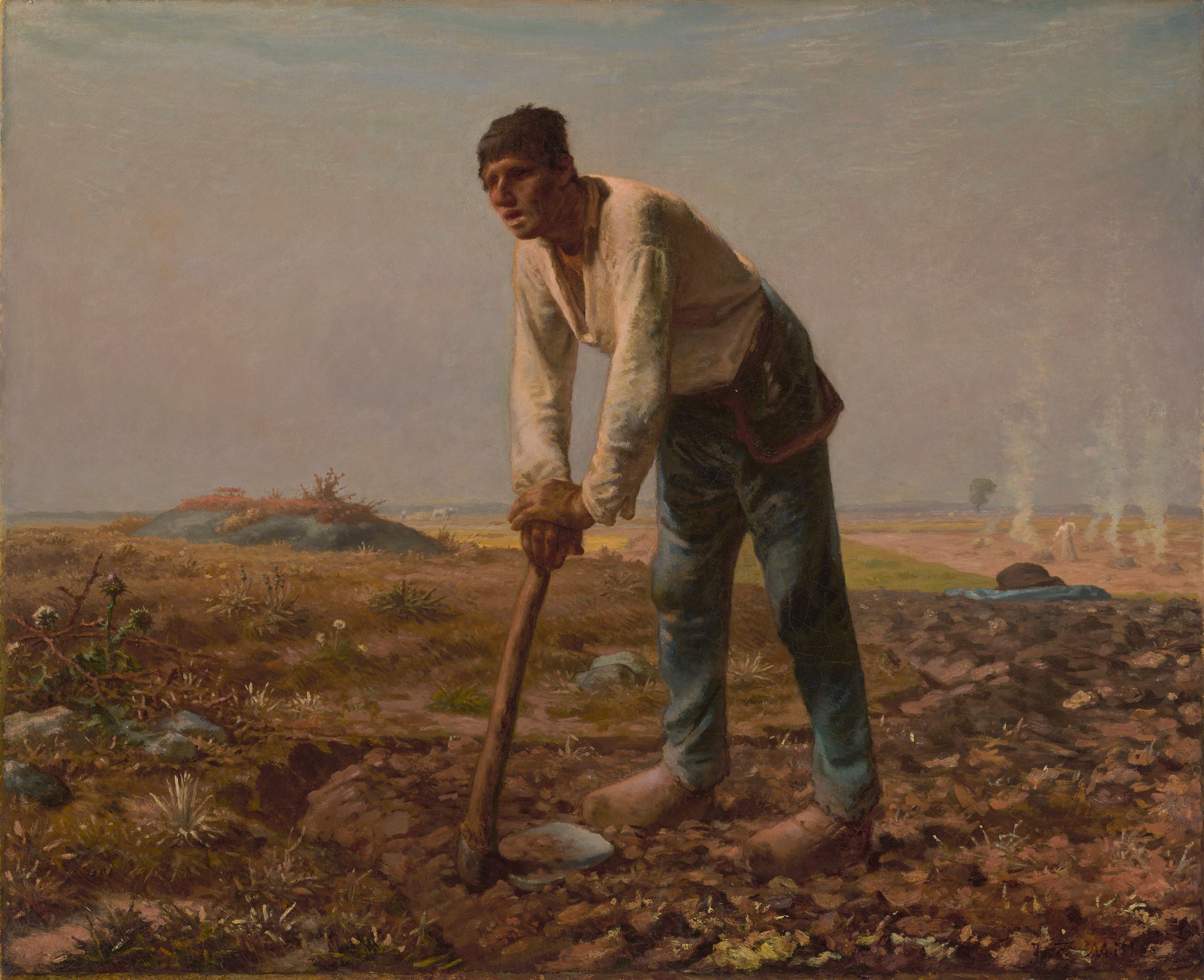
In the early 1920s, Jean-Charles Millet was struggling to break into the Parisian art scene. The shadow of his grandfather, Jean-François Millet, weighed heavy.
The elder artist’s unflattering paintings of agrarian life were revered and would prove references for the likes of Vincent van Gogh and Claude Monet. Following Millet’s death in 1875, the market for his paintings soared. The work of his grandson, by comparison, was deemed derivative.
Short of funds, Jean-Charles sold a handful of his grandfather’s drawings to Andre Douhin, a businessman who had bought Jean-François’ country studio in Barbizon and turned it into a tourist attraction. The exchange would spark a duplicitous scheme. Armed with his grandfather’s studio stamp and no little painterly talent, he began producing and selling imitation works.
One such forgery was a preparatory oil study for Man with a Hoe (1860–2), considered among Jean-Charles’ greatest works — one whose image had circulated widely through the development of new reproductive technologies.
When the fake was listed in David Croal Thomson’s 1925 catalog, the art dealer caught the imagination of buyers by reminding them it was Jean-François’s most “magistral and monumental” painting, while incorrectly stating that it had been destroyed during the San Francisco earthquake of 1906. The fake sketch promptly sold to an affluent Montreal family.
By 1935, its faulty provenance was revealed in a Fontainebleau trial that charged Jean-Charles with running a fake art factory, one that also churned out copycat Corots and Manets.
Jean-François Millet, Man with a Hoe (ca.1860–2). Image: courtesy the Getty
This story of an entitled and bitter young artist is on display at Los Angeles’ Getty Center (runs until December 10). Nearly a century on from its glowing catalogue entry, the fraudulent oil study—still held by the same Canadian family—is placed alongside the ‘authentic’ Millet, along with period works that echo the image and speak to its popularity.
“Millet’s highly original art seemed to be rooted in a timeless, agrarian world and I think this appealed hugely at a time of rapid modernization, urbanization, and industrialization—with all their attendant social upheaval,” said Scott Allan, Getty’s curator of paintings. “Millet’s art, moreover, seemed to have a unique authority and authenticity that was guaranteed by his own humble rural origins.”
Part of the painting’s appeal was its flexibility. People saw in it what they wanted. For religious conservatives on the right, it offered a scene of humble peasant piety. For social reformers on the left it carried forth the ideals of the French Revolution. For collectors, it was a fresh take on a timeless subject and broke from the picturesque conventions common to early 19th century painting.
The differences may be less discernable to casual art goers than eagle-eyed curators, but in “Reckoning with Millet’s Man with a Hoe” that’s part of the fun. Visitors are encouraged to look closely and mull over what, exactly, the grandson lacked and why the work of Jean-François Millet resonated so strongly with audiences of the late 1800s.
For the experts, the differences are clear, all the more so after x-rays. The mere existence of an oil study was uncharacteristic for Jean-François, who by the 1860s was a confident and long-established painter. Equally dubious is the posture offered in the preparatory oil study. X-rays reveal that he tinkered with the farmer’s pose, while the study offers it as already settled. The kicker? Jean-Charles’ work is too detailed, too carefully faithful for a rough sketch.
Greed, inevitably, proved Jean-Charles’ downfall. In around a decade, he would produce more than 200 fake Millet works, eventually piquing the suspicion of dealers. At trial, he was unrepentant, smug even, claiming many buyers were unsophisticated and preferred his forgeries to the originals. In Los Angeles, visitors can see if they agree.
See more exhibition images:
Jean-François Millet, Digger Resting (ca. 1847). Image: courtesy LACMA.
Louis-Joseph Ghémar, Caricature of Man with a Hoe (1868). Image: courtesy the Getty.
“Caricature of Man with a Hoe”, 1863, Le Charivari. Image: courtesy the Getty.
Kubota Beiseni, Man with a Hoe (1893). Image: courtesy the Getty.
More Trending Stories: